 |
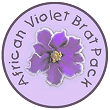
On Site







Off Site

Back-up
Brat Forum |
Going To Pot
by Yvonne Costanza
Clay pots are very porous. The porosity allows air and water to get to the plant's root system. The evaporation that occurs with clay pots keeps the potting mix cooler in hot climates. The porosity also makes the potting mix dry out quicker requiring more frequent watering. As the air and water move through the clay, salts in the water can accumulate on the rim of the clay pot. Over time, the salt build up can injure the leaf petioles and lead to petiole rot. Algae can also grow on the outside of the clay pot.
Plastic pots are not porous so the water does not evaporate as quickly and the potting mix stays moist longer. They are not as prone to salt build up on the rim, but if it occurs, the plastic surface is easier to clean. Plastic pots come in many shapes and sizes.
3 oz. solo cups are commonly used to start leaves and for potting individual babies.
|
|
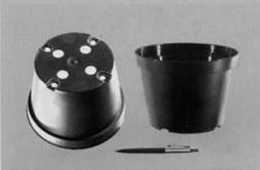 Round Pots
Round Pots
(photo courtesy of Bluebird Greenhouse)
Round plastic tub pots (or azalea pots as they are called) are wider than they are tall. They are available in sizes ranging from 2 1/8" - 6" from many african violet supply vendors and in even larger sizes from other nurseries and garden shops.
|
|
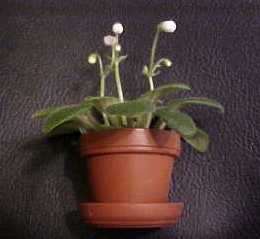 Thumb Pot
Thumb Pot
(photo courtesy of Yvonne Costanza)
Thumb pots are 1 1/2" round plastic pots used for micro miniature violets.
|
|
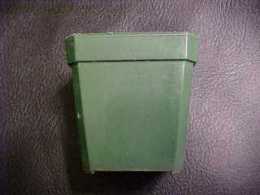 Square Pots
Square Pots
(photo courtesy of Yvonne Costanza)
Square plastic pots have the same properties as round pots.
|
|
 Pan Pots
Pan Pots
(photo
courtesy of Bluebird Greenhouse)
Pan pots are very shallow round plastic pots used for trailing african violets.
|
|
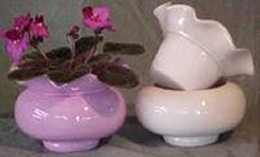 Two-piece Ceramic Pots
Two-piece Ceramic Pots
(photo
courtesy of Bluebird Greenhouse)
Two piece ceramic pots have a larger, fully glazed outer pot that serves as the water reservoir. The smaller insert is glazed on the rim, but not on the lower part, where the plant is potted. The unglazed insert fits in the outer reservoir and the porous surface allows fertilizer and water to transfer into the insert and to the plant's roots.
Ceramic pots come in many shapes, sizes and colors that are not available in clay or plastic. The violet can be potted directly into a ceramic pot if it has a drain hole. If the ceramic pot does not have a drain hole, the violet can be potted in a plastic pot and placed in the ceramic pot.
|
|
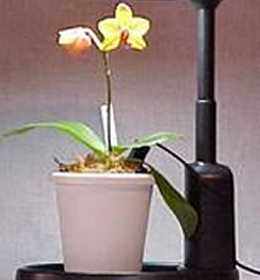
Oyama Planter
(photo
courtesy of Violet Showcase)
Oyama planters are two piece, plastic, self watering planters made especially for african violets. The plant is in the slitted inner pot with a layer of perlite at the bottom and a potting mix of at least 50% perlite. The fertilizer and water are drawn up into the perlite and into the potting mix.
|
|
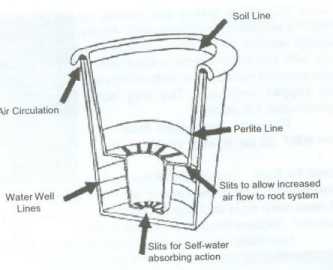
Oyama Planter, cross section (courtesy
of Violet Showcase)
|
|
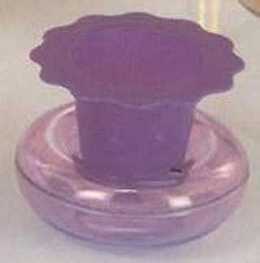
Dandy Pot
(photo
courtesy of Bluebird Greenhouse)
Dandy pots are a combination of pot and wicking reservoir. The opaque plastic flower pot and translucent reservior are available in white, pink, blue, lavender, terra cotta, or green. They are available in 3 1/2" and 2 1/8" sizes.
|
|
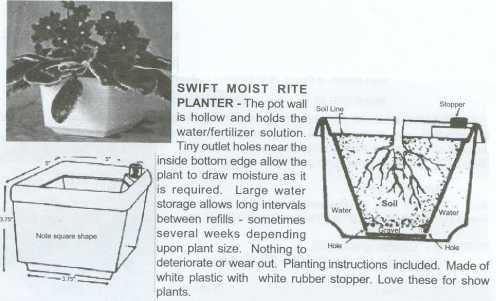
Swift Moist Rite Planter
(photo courtesy of Violet Showcase)
Swift Moist Rite Planters are square shaped pot with smaller inner chamber which contains outlet holes. The larger outer water reservoir has small hole and stopper where water is replaced.
|
|
Bemis planters. The smaller sizes of Bemis planters, used for african violets, are being discontinued by the manufacturer.
|
|
|